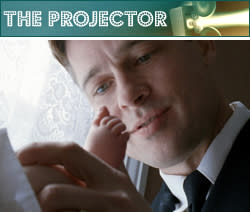Review: ‘The Tree of Life’

For all of the well-known trademarks of writer-director Terrence Malick's films -- their use of poetic voiceover, their depictions of Edens destroyed by humans, their meditative tone -- he's never made a movie quite like "The Tree of Life." Then again, few have: A film that marries the cosmic mysteries of the universe to the familiar domestic drama of 1950s American life, "The Tree of Life" is boldly ambitious, stunning conceived, and occasionally transporting. Unfortunately, it's also probably Malick's most frustrating film.
"The Tree of Life" doesn't have a story as much as it has movements, not unlike a piece of music. But while Malick takes time to show us the creation of Earth and the development of life on the planet -- yes, including the dinosaurs that you've probably heard about from the pre-release buzz -- the central plot involves a '50s Texas married couple (Brad Pitt and Jessica Chastain) and their three boys, particularly their oldest son Jack (Hunter McCracken). Occasionally, we also see Jack as an adult in modern times (played by Sean Penn) who seems to be emotionally adrift, although the cause of his malaise is never spelled out.
To explain what "The Tree of Life" is "about" is futile because, like all of Malick's films (especially "Days of Heaven" or "The Thin Red Line"), this is a movie that you experience rather than worry over the plot specifics. Nifty storytelling has never been Malick's forte: As usual for him, the narrative of "The Tree of Life" is merely a clothesline to hang his gorgeous visual ideas and thematic interests on. Visually, the movie is a wonder; thematically, it's less surefooted.
Working with Douglas Trumbell, the visual effects maven who has lent his expertise to everything from "Close Encounters of the Third Kind" to "Blade Runner," Malick early on creates a wordless sequence about the birth of the planet that is one of the most astonishing set pieces he's ever assembled. Recalling both the opening and finale of the seminal "2001: A Space Odyssey" (another film Trumbell has on his résumé), the sequence is visually and sonically overpowering, suggesting both the randomness and the subtle structure of the universe.
Elsewhere, Malick and cinematographer Emmanuel Lubezki shoot Pitt and McCracken's storyline almost exclusively with Steadicam, giving the scenes a sense of floating that suggests either a deity watching the action or fragments of memory held onto by the adult Jack. It's easy to describe Malick's films in general as "dreamy," but before "The Tree of Life" they've been largely set in nature, which helped amplify that sensation. But whether it's Pitt's '50s small-town life or Penn's intimidating urban metropolis, "The Tree of Life" is the first time Malick has explored cities, and yet he still manages to create a poetic, ethereal landscape that feels as if it could evaporate at any moment.
As beautifully shot and conceived as "The Tree of Life" is, however, the film's central characters remain confounding and opaque, which is all the more disappointing because they seem to come from the heart. Himself one of three brothers who grew up in Texas in the '50s, Malick appears to have drawn from personal recollections for this film, even down to the fact that one of the brothers died young. (Adding to the similarities, Jack, like Malick, was the oldest son.) But whether or not "The Tree of Life" is autobiographical, the film feels like a form of therapy, with young Jack and his dad engaging in a classic father-son power struggle that's almost Biblical in its directness.
Nonetheless, no matter how emotionally charged these scenes are, there's something undeniably simplistic in the portrayal of this family with its alpha-male father and shrinking-violet mother. Plus, despite McCracken's sensitive performance, young Jack's development from sweet to callous isn't particularly interesting or novel. Malick's characters have always seemed to be in a trance, which is part of his films' remarkable spell, but the characters in "The Tree of Life" feel more like symbols than flesh-and-blood people, which greatly reduces the film's emotional power.
The movie's symbolism doesn't stop at the characterizations, though: Considering that Jack's childhood and midlife issues are just part of this film, it's clear that Malick is wrestling with larger concerns, including regret, the existence of God, our place in the universe, the meaning of life, and whether there's anything waiting for us after we die. Consequently, "The Tree of Life" aims higher and digs deeper than most films would ever dare. And while I can't say Malick entirely succeeds, even this film's missteps and ponderous moments have an integrity that earns your respect. For all the talk of Malick being a true artist -- not just a measly filmmaker -- "The Tree of Life" is the movie of his that most unabashedly aspires to the level of high art, seeking to answer the big questions and deliver a tour de force cinematic experience. Such nerve ought to be commended, even if he doesn't get all the way there.
Grade: B


